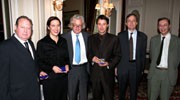The winners were :
First Empire Emmanuel de WARESQUIEL: Talleyrand, le prince immobile, Paris: Éditions Fayard, 2003
Second Empire Nicolas STOSKOPF: Banquiers et Financiers parisiens, Paris: Éditions Picard, 2002
Book in a language other than French L. et J. ZEITZ: Napoleons Medaillen, Petersberg: Michael Imhof Verlag, 2003
Prize for a Napoleonic film Antoine DE CAUNES: Monsieur N, Loma Nasha Production (Pierre Kubel), 2003
Emmanuel de Waresquiel, winner with Talleyrand le prince immobile
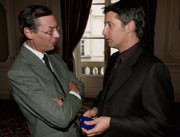 Previously of the Ecole Normale Supérieure, doctor in history, researcher at the École Pratique des Hautes Etudes, Emmanuel de Waresquiel is the author of several books, including notably the biography Duc de Richelieu, un sentimental en politique (Perrin, 1991).
Previously of the Ecole Normale Supérieure, doctor in history, researcher at the École Pratique des Hautes Etudes, Emmanuel de Waresquiel is the author of several books, including notably the biography Duc de Richelieu, un sentimental en politique (Perrin, 1991).
Using many previously unpublished sources, Emmanuel de Waresquiel here gives a careful view of Talleyrand, stripping away the 'black legend', but not denying that politician's skill at manipulation. Talleyrand was a man born into the Ancien Régime, and it was here that he learnt his life's most important lesson, namely the art of appearing in society (whilst at the same time developing a taste for secrecy and game playing). He was pugnaciously tenacious in his political and economic beliefs, whilst remaining pliant enough to be able to bend his action, rather than his ideas, to events.
Nicolas Stoskopf, winner with Les patrons sous le Second Empire. Banquiers et Financiers parisiens
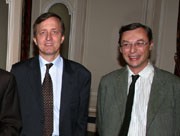 This biography of about one hundred entrepreneurs who, for the most part, worked during the Second Empire in the zone between Rue de la Chaussée-d'Antin and Rue du Faubourg-Poisonnières, plunges the reader into the heart of French 19th-century capitalism. It moves from beginnings during the Restoration, with the initial successes of James de Rothschild in Paris, to the foundation of the Caisse d'épargne and the insurance companies, state loans issued by a powerful bank in the making, continuing up to the bank crashes of the 1880s, which sealed the fate of the multi-function bank in France. The book also discusses the construction of the railways in France, the revolution in banking, the transformation of the urban landscape, the investments in mining and steel-making, and international trade, ranging wide in its geographical spread as far as the US, Russia, the Maghreb, Egypt, and Ottoman Turkey.
This biography of about one hundred entrepreneurs who, for the most part, worked during the Second Empire in the zone between Rue de la Chaussée-d'Antin and Rue du Faubourg-Poisonnières, plunges the reader into the heart of French 19th-century capitalism. It moves from beginnings during the Restoration, with the initial successes of James de Rothschild in Paris, to the foundation of the Caisse d'épargne and the insurance companies, state loans issued by a powerful bank in the making, continuing up to the bank crashes of the 1880s, which sealed the fate of the multi-function bank in France. The book also discusses the construction of the railways in France, the revolution in banking, the transformation of the urban landscape, the investments in mining and steel-making, and international trade, ranging wide in its geographical spread as far as the US, Russia, the Maghreb, Egypt, and Ottoman Turkey.
Lisa and Joachim Zeitz, winners with Napoleons medaillen
 The book was researched and written by a father/daughter team: Dr Lisa Zeitz is an art correspondent for the Frankfurter Allgemeine Zeitung in New York. Dr. Joachim Zeitz is an orthopaedic doctor in Bad Homburg and author of two books on medals from his native region, the former Grand Duchy of Baden.
The book was researched and written by a father/daughter team: Dr Lisa Zeitz is an art correspondent for the Frankfurter Allgemeine Zeitung in New York. Dr. Joachim Zeitz is an orthopaedic doctor in Bad Homburg and author of two books on medals from his native region, the former Grand Duchy of Baden.
Napoleon was very fond of medals and early on recognized their power to spread a message, and he was to make them a central pillar of his public relations campaign, immortalising his successes with a whole series of them.
In 1815, just before the end of Napoleon's reign, Vivant Denon, director of the Musée Napoléon and of the medal mint, published a collection of 141 medals constituting the Emperor's “histoire métallique.” This “history in metal” documents and glorifies not only Napoleon's military career – from Italy to Hamburg, from Egypt to Madrid -, but also his civil accomplishments, ranging from the introduction of public vaccination to the building of transalpine roads. The best artists of the time were employed to create symbolic images for the medals. Expert coin photographer, Manfred Czastka, provided the excellent colour images for the book, which show the medals not only in their original size but also in threefold enlargement.
Antoine De Caunes (director) and Pierre Kubel (producer), winners with Monsieur N
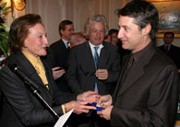 A crime thriller built on a historical enigma: Napoleon's last battle
A crime thriller built on a historical enigma: Napoleon's last battle
1815. After the Hundred Days and his brief return to power, Napoleon, defeated, asked the British for asylum. But they treated him as a prisoner of war and sent him to Saint Helena, in the company of a group of followers, some faithful, others cynical. How could Napoleon, the man of all battles, the genius of military and political strategy, bear to accept this imprisonment on the high seas? What system of defence – or rather attack – would he adopt to escape the grasp of his jailers?
On Saint Helena, on an unreachable island chosen by his enemies, Napoleon fought a mysterious battle, his last and most important. The battle that history had never told…
In 2003, Fondation Napoléon Research Grants were awarded to six young historians
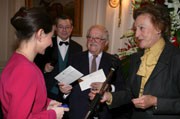 The FIRST EMPIRE Research Grants 2003 support research in the following areas :
The FIRST EMPIRE Research Grants 2003 support research in the following areas :
• The sénat conservateur of An VIII, a second, constituent assembly, by Clémence Zacharie-Tchakarian
• Saragossa during the French occupation after the sieges of the Peninsula War 1809-1813, by Anne-Sophie Galofaro-Darmagnac
The SECOND EMPIRE Research Grants 2003 support research in the following areas :
• Pierre-Victor Galland (1822-1892), painter and decorator, by Jeremy Cerrano
• The Quay d'Orsay and the diplomats in Second Empire foreign policy, by Yves Bruley
The FIRST and SECOND EMPIRE Research Grants 2003 support research in the following areas :
• The life and work of Auguste Couderc (1789-1873), history painter, by Joanna Walkowska
• The Arc de Triomphe, the construction and appropriation of a national monument 1806-1945, by Isabelle Rougue-Ducos


